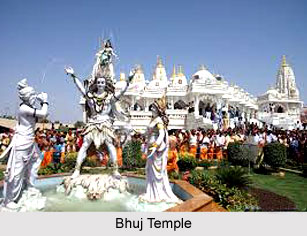 The old walled city of Bhuj in Gujarat is the most significant town in Kutch serving as its district headquarters. Bhuj is distinguished by its ornately decorated Hindu temples, beautiful palaces and intricately carved wooden pavilions. It is a paradise for handicraft lovers and weavers. The oldest museum is situated in Bhuj. The region is also well known for the enamel work done on gold and silver jewellery, lacquered wood, seashell toys and metal bells.
The old walled city of Bhuj in Gujarat is the most significant town in Kutch serving as its district headquarters. Bhuj is distinguished by its ornately decorated Hindu temples, beautiful palaces and intricately carved wooden pavilions. It is a paradise for handicraft lovers and weavers. The oldest museum is situated in Bhuj. The region is also well known for the enamel work done on gold and silver jewellery, lacquered wood, seashell toys and metal bells.
Puraneshwar Temple , Kutch, Gujarat : Puraneshwar is about 35 km from Bhuj. The temple is the product of the 9th-10th century, built on a high plinth, containing some extremely well woven sculpture on its walls. Near the temple complex is a place called Vadimedi, a palace dating back to the Solanki era.
Shiva Temple, Kera, Kutch, Gujarat: Kera is renowned for its 10th century Shiva Temple. The present day ruins are suggestive of how beautiful the temple must have been centuries ago. Sadly, the temple was damaged in the epoch-making earthquake of 1819AD. Very near to this ruined Shiva temple, is a Muslim shrine of Ghulam Ali Shah. The annual Urs held here attracts devotees from all faiths. Earnest worshippers walking on smoldering coal is the prime attraction of Urs.





















